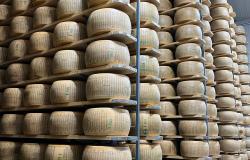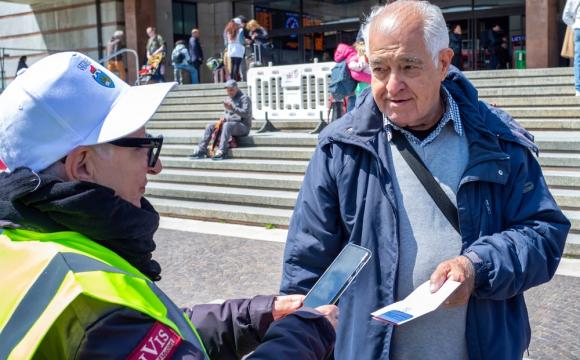For art lovers, pilgrims and historians, the name of Ravenna is synonymous with the greatest Byzantine mosaics of the early Christian era, with no less than eight buildings, which have stood for an astonishing millennium and a half, on the UNESCO Heritage of Humanity list. But those of us who only have a day will discover that Ravenna is alive with a vitality that echoes the name of its patron saint, San Vitale, a Roman who chose martyrdom rather than renounce his Christian beliefs.
Situated near the Adriatic coast, Ravenna may not be as great as Rome or exotic as Constantinople (Istanbul), yet it was where imperial Rome had its last gasp when in 402 it became the capital of the Western Empire. By 476 the Western Empire had collapsed but for another two hundred years Ravenna played a strategic role, both religious and political, reaching its height under the reign of Justinian from 527 to 565 as the seat of Byzantine power in Italy.
By 476 the Western Empire had collapsed but for another two hundred years Ravenna played a strategic role, both religious and political, reaching its height under the reign of Justinian from 527 to 565 as the seat of Byzantine power in Italy.
It’s only in the last fifty years that Ravenna has seen a revival, becoming an important industrial centre, and the rediscovery of its vast wealth of art treasures has energized the thriving market town in a most refreshing way.
Getting there
 Getting to Ravenna is relatively easy, about two hours south of Venice, and an easy train hop from Milan or Bologna. There are no tortuous mountain roads, only a tangle of outer suburbs and you’re in the central district where there are plenty of parking areas.
Getting to Ravenna is relatively easy, about two hours south of Venice, and an easy train hop from Milan or Bologna. There are no tortuous mountain roads, only a tangle of outer suburbs and you’re in the central district where there are plenty of parking areas.
First off I like to have a heart-starter coffee in the Café Roma, with tables spilling into the Piazza del Popolo where you can really get a feel for the centre of Ravenna and watch the world cycle by. The Piazza is an excellently proportioned rectangle, big enough and intimate at the same time. Two Venetian-style columns with Saint Apollinare, first bishop of Ravenna and San Vitale, offer an elegant salute to the important religious heritage of Ravenna in front of the Palazzo del Commune and on the left the beautiful Palazzo Veneziano, built when Ravenna was part of the Venetian Republic in the 15th Century.
The Piazza is an excellently proportioned rectangle, big enough and intimate at the same time. Two Venetian-style columns with Saint Apollinare, first bishop of Ravenna and San Vitale, offer an elegant salute to the important religious heritage of Ravenna in front of the Palazzo del Commune and on the left the beautiful Palazzo Veneziano, built when Ravenna was part of the Venetian Republic in the 15th Century.
From here take Via IV Novembre to Piazza A Costa where you can peruse a superb covered market. Heading south, stroll down the beautiful Via Cavour, a delightful shopping precinct boasting brilliant fashion boutiques and jewellery shops. You may see a bride being fitted for her big day. Take a right at Via Salara and immediately left at Via San Vitale. The Information office is just on the left and you can pick up a handy map. Continue until you reach the Church of San Vitale. Entering the complex find your way to the office where you can buy a compilation ticket to five of the major sites for 27.50. The group of buildings you are now at includes the two most famous, the Basilica of San Vitale and the Mausoleum of Galla Placidia.
You may see a bride being fitted for her big day. Take a right at Via Salara and immediately left at Via San Vitale. The Information office is just on the left and you can pick up a handy map. Continue until you reach the Church of San Vitale. Entering the complex find your way to the office where you can buy a compilation ticket to five of the major sites for 27.50. The group of buildings you are now at includes the two most famous, the Basilica of San Vitale and the Mausoleum of Galla Placidia.
Shining examples
 San Vitale is an exotic fusion of eastern geometry and Christian iconography. The impact of the internal circular structure and spectacular mosaics is astounding. Shafts of light flicker over the ageless coloured and golden tiles depicting the enigmatic faces of a wide- eyed, jewel-encrusted beauty; the Empress Theodora, the stern-browed Emperor Justinian and the gentle open face of Christ the Redeemer. It seems that every surface is adorned – triumphal arches, apses and domes in glass carpets of wonder and amazement.
San Vitale is an exotic fusion of eastern geometry and Christian iconography. The impact of the internal circular structure and spectacular mosaics is astounding. Shafts of light flicker over the ageless coloured and golden tiles depicting the enigmatic faces of a wide- eyed, jewel-encrusted beauty; the Empress Theodora, the stern-browed Emperor Justinian and the gentle open face of Christ the Redeemer. It seems that every surface is adorned – triumphal arches, apses and domes in glass carpets of wonder and amazement. Fifteen years later the great Church of Aghia Sofia in Istanbul was built using San Vitale as its basic design.
Fifteen years later the great Church of Aghia Sofia in Istanbul was built using San Vitale as its basic design.
The nearby mausoleum is a nondescript small brick building whose ordinariness belies the startling beauty of the internal mosaics and astonishing life of the woman buried here in 450, having been the power behind the imperial throne for 20 years. Amongst other things this is the first depiction of Saint Peter holding the keys to heaven. Retracing your steps to Piazza A Costa you could grab a picnic lunch from one of the many gourmet stalls but I recommend the Ristorante Cantina Cappello with its light lunches of salad and pasta and great selection of wines. Back to Piazza del Popolo, pass the columns and enter another crowded shopping street full of art deco frontages and pretty glass porticos in Via Cairoli. Take the next left and continue past Piazza Garibaldi and on to the main thoroughfare of Via Roma. Cross this, turn right and you’ll find Sant’ Apollinare Nuovo.
Retracing your steps to Piazza A Costa you could grab a picnic lunch from one of the many gourmet stalls but I recommend the Ristorante Cantina Cappello with its light lunches of salad and pasta and great selection of wines. Back to Piazza del Popolo, pass the columns and enter another crowded shopping street full of art deco frontages and pretty glass porticos in Via Cairoli. Take the next left and continue past Piazza Garibaldi and on to the main thoroughfare of Via Roma. Cross this, turn right and you’ll find Sant’ Apollinare Nuovo.
A crowded stable
 This Basilica was founded by Theodoric in the 5th century as an Arian church, a branch of the early faith that did not believe in Christ’s divinity, a belief that was soon quashed by the law of Constantinople.
This Basilica was founded by Theodoric in the 5th century as an Arian church, a branch of the early faith that did not believe in Christ’s divinity, a belief that was soon quashed by the law of Constantinople.
One of the earliest mosaics is on the left wall, consisting of 22 virgins in gold embroidered tunics, preceded by the Three Kings in extraordinary patterned hose, and the Virgin Mary enthroned with the Holy Child on her lap surrounded by four angels.
Leaving the basilica, directly opposite you enter Via F Negri where you’ll find the Mosaic Art School that run five-day courses in traditional and contemporary mosaic in English taught by Luciana Notturni (www.mosaicschool.com). Continue along, across Largo Firenze to Via Guaccimanni to Piazza Caduti. Take the diagonally opposite street then left to Piazza Arcivescovado (your ticket from San Vitale will give you entrance to the Archiepiscopal Museum) and you can enter alongside the Cathedral to the Neonian Baptistery (you have the ticket) and see a naked Christ being baptised, surrounded by 12 apostles, 16 prophets and a world richly depicted in harmonious Christian iconography.
Take the diagonally opposite street then left to Piazza Arcivescovado (your ticket from San Vitale will give you entrance to the Archiepiscopal Museum) and you can enter alongside the Cathedral to the Neonian Baptistery (you have the ticket) and see a naked Christ being baptised, surrounded by 12 apostles, 16 prophets and a world richly depicted in harmonious Christian iconography.
At this point you will well and truly feel like you’ve had your fill of Saints preserved for all eternity in the glistening glory of never-fading tiles and, in the late afternoon light, you can return to Piazza del Popolo, enjoy an aperitif while the locals crisscross the square on their bikes in what passes for the Ravenna rush hour.







